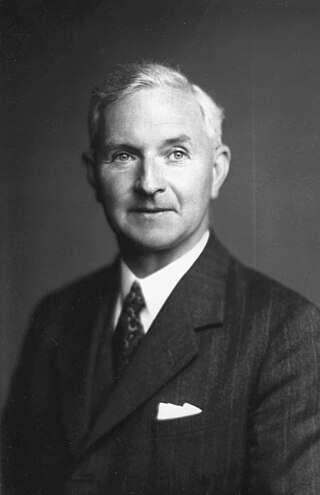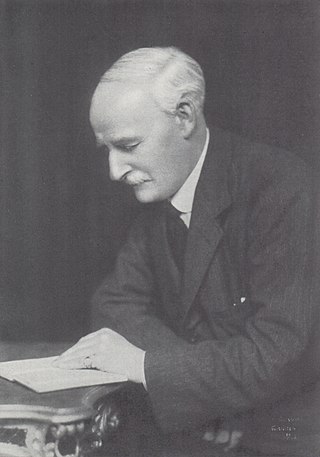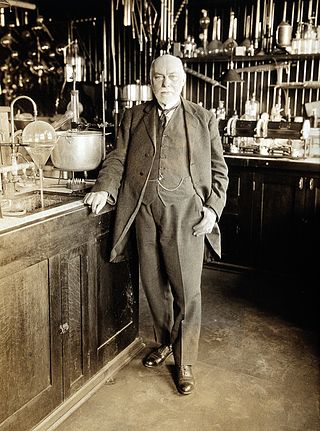Related Research Articles

Sir John Edward Lennard-Jones was a British mathematician and professor of theoretical physics at the University of Bristol, and then of theoretical science at the University of Cambridge. He was an important pioneer in the development of modern computational chemistry and theoretical chemistry.

Sir Robert Robinson was a British organic chemist and Nobel laureate recognised in 1947 for his research on plant dyestuffs (anthocyanins) and alkaloids. In 1947, he also received the Medal of Freedom with Silver Palm.
Sir Ian Heilbron DSO FRS was a Scottish chemist, who pioneered organic chemistry developed for therapeutic and industrial use.

George Barger FRS FRSE FCS LLD was a British chemist.

Percy Faraday Frankland CBE FRS was a British chemist.

Sir Thomas Hill Easterfield was born in Doncaster the youngest of four children of Edward Easterfield, savings bank secretary, and Susan. He attended Doncaster Grammar School, and later entered the Yorkshire College of Science, now the University of Leeds. He was then appointed a Senior Foundation Scholar of Clare College, Cambridge, from where he gained First Class honours in the Natural Sciences Tripos in 1886.
Geoffrey Edward Coates was an English organometallic chemist and academic. He developed the basics for new materials in plastics, semiconductors and pharmaceuticals.
Richard Maling Barrer FRS was a New Zealand-born chemist. His areas of research included gas permeability of membranes and zeolite science, of which he was a founding figure; he also gave his name to the zeolite Barrerite. The Barrer, a unit of gas permeability, is also named after him.

Arthur Smithells, CMG FRS was a British chemist.
John Edwin MacKenzie FRSE OBE (1868-1955) was a Scottish chemist.
Alice Emily Smith was a British chemist and one of the nineteen signatories of the 1904 petition to the Chemical Society.
John Monteath Robertson FRS FRSE PCS CBE LLD (1900–1989) was a 20th-century Scottish chemist and crystallographer. He was the recipient of the Davy Medal in 1960 and president of the Chemical Society from 1962 to 1964.
The Longstaff Prize is given to a member of the Royal Society of Chemistry who has done the most to advance the science of chemistry. First awarded in 1881, it was originally conferred by the Chemical Society and known as the Longstaff Medal.
George Gerald Henderson was a chemist and professor at the University of Glasgow. He was known for his work on terpenes.
Charles Rugeley Bury was an English physical chemist who proposed an early model of the atom with the arrangement of electrons, which explained their chemical properties, alongside the more dominant model of Niels Bohr. In some early papers, the model was called the "Bohr-Bury Atom". He introduced the word transition to describe the elements now known as transition metals or transition elements.

Frederick Belding Power was an American chemist who worked in pharmacology, plant chemicals, and on standards in pharmaceutical production. He served as a professor of pharmacy at the Philadelphia College and as director of pharmacy at the University of Wisconsin–Madison. He also served as a chemist for the Wellcome Chemical Research Laboratories in London where he examined Chaulmoogra oil and its use in the treatment of leprosy.
John Albert Newton Friend was a British chemist and educator who specialized in the chemistry of corrosion and its prevention. He was among the first to note that chromium enhances the corrosion resistance of steel. He edited a multi-volume textbook of inorganic chemistry.

Joseph E. Coates, OBE was a physical chemist and academic. He was the first Professor of chemistry and head of the department of Swansea University.
The South Wales West Local Section is one of 35 local sections of the Royal Society of Chemistry in the UK and Ireland. It covers an area including the Local Authority areas of Bridgend, Carmarthenshire, Neath Port Talbot, Pembrokeshire and Swansea.
References
- ↑ Shorter, John (1998). "Some pioneers of the kinetics and mechanism of organic reactions". Chemical Society Reviews. 27 (5): 355. doi:10.1039/a827355z. ISSN 0306-0012.
- ↑ "Professor Kennedy Orton". The Times. 24 March 1930. p. 19.
- ↑ "Professor Orton". The Times. 19 March 1930. p. 19.
- ↑ University of Cambridge; Venn, John; Venn, J. A. (John Archibald) (1922–54). Alumni cantabrigienses; a biographical list of all known students, graduates and holders of office at the University of Cambridge, from the earliest times to 1900;. Robarts - University of Toronto. Cambridge, University Press.
- ↑ "Kennedy J. P. Orton". Ibis. 73: 100. 1931. doi:10.1111/j.1474-919X.1931.tb01508.x.
- ↑ Lucas, A.; Jones, E. Gabriel; David, T. W. Edgeworth; Goulding, Ernest; Bolton, E. R. (1931). "Obituary notices". Journal of the Chemical Society (Resumed): 1042. doi:10.1039/jr9310001024. ISSN 0368-1769.
- ↑ Angus, W. Rogie (1954). "Journal of the Royal Institute of Chemistry. June 1954". Journal of the Royal Institute of Chemistry. 78 (June): 291–298. doi:10.1039/ji9547800289. ISSN 0368-3958.